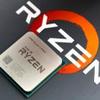Introduction
AMD Ryzen 7 1700X
Will a 100 bucks cheaper CPU offers close to similar 1800X performance?
In this review we'll be looking at the Ryzen 7 1700X processor, this little brother of the 1800X is 100 USD cheaper, yet offers close to the same performance, including very similar tweaking characteristics. After our first review we already have been able to establish that the Ryzen 7 series offers tremendous multi-threaded performance for the money. And while this new platform still might have a thing or two that needs to be fixed, the series oozes value. In this review we'll also be looking at gaming SMT on/off performance to see if that will boost gaming performance a bit better.
Note: the basic content in this article remains the same as in the 1800X article, but obviously we swapped out the 1800X for the 1700X photos and content wise.
The eagle has landed and we’re very happy to present you guys with our second Ryzen review. Zen was initially the development codename for the new architecture, and as such we should probably drop that name immediately and move to Ryzen. Well, actually I need to elaborate even a little more -- to make matters a little more complicated, the codename for today's released 8-cores (16 threads) processor is in fact "Summit Ridge". As you guys have learned over the past few months, the 8-core Summit Ridge processor series from AMD is also the first Ryzen based product series released to the desktop consumer market. The architecture has been fabbed at a more efficient and optimized 14 nanometer FinFET process, rather than the 32 nm and 28 nm processes of previous AMD FX CPUs and AMD APUs, respectively. AMD's processors and APUs over the years have run their course really, for the gamer and more mainstream PC aficionado the older FX and APU series simply lack in raw processor performance compared to what the competition has been offering. We discussed it many times in the reviews, but if you compared an Intel processor core and an AMD processor core and clocked them at the very same frequency, Intel was almost half faster. The effect of that phenomenon showed in the less optimized and threaded applications, many games are a good example here. Today's tested product is to deliver, per CPU core, more than 40 percent improvement in instructions per clock cycle over the previous generation cores and will come to market first in an 8-cores, 16-threads system-on-chip for desktops, and that my friends is Summit Ridge. The new "Summit Ridge" Zen family will use the unified AM4 socket. Ryzen, and in particular today "Summit Ridge" is the high-end desktop (HEDT) product.
We have seen a lot of info go viral over the past few weeks, but I stated it many times, the initial product launch will entail only this 8-core part, followed in Q2 2017 by six and four core processors. Much like the competition AMD will be selling Ryzen in product stacks, low-end, mid-range and high-end much like Intel's Core i3, i5 and i7 series. Earlier on referred to as SR7, SR5 and SR3, matching up with Summit Ridge (SR) and thus a performance segment denominator. But then Summit Ridge from the new Zen architecture was named Ryzen, and hence one more change in naming has now been made. You will see Ryzen series 3, 5 and 7 processors. It’s plain and simple, and as always that works out the best to understand product positioning, we’ll go into more detail on the next few pages, of course.
The Ryzen series 7 processors are eight core processors at attractive pricing combined with an IPC increase of roughly 52%. They come with four integer units, two address generation units and four floating point units, the decoder can decode four instructions per clock cycle. L1 data cache size is 32 KiB and 64 KiB for instructions, the L2 cache size is a whopping 512 KiB per core. Two of the floating point units are adders, two are multipliers. One unit that holds four processors is a CCX (core complex). Ryzen 7 is an 8-core processor series and thus that means 2 CCXs x 8 MB (L3) + 8 x 512 KB (L2) = 20 MB in total for L2 and L3 caches. These numbers sound familiar, eh (Intel)? Today is obviously not just about the processors, au contraire Mon ami, you are going to need a new motherboard as well of course.
It Takes Two: The Chipset(s)
AMD sold its chipset division I think two years ago already, a new processor series will need a new chipset as the motherboard needs an infrastructure as well. This has been outsourced and at launch you will see multiple product stacked motherboard chipsets. For Ryzen, you probably want a high-end / enthusiast class chipset with lots of features and tweaking options, this will be the X370 chipset that goes along with the launch of the processor series release. At launch there should be at least a dozen or so choices available. X370 will give home to the new socket AM4 and will provide high-frequency DDR4 memory support (as well as all other modern usual suspects like USB 3.1 gen 2, SATA Express, as well as NVMe protocol based M.2 support and surely PCI-Express Gen 3.0). At launch, over 82 motherboards will be released by several partners. Bear in mind that there will be multiple chipsets, for Socket AM4 namely the X370, B350, A320, X300 and A300. We’ll go into a little more detail later in this article.
Overall we have lots to talk about, let’s start up the review, next page please...


